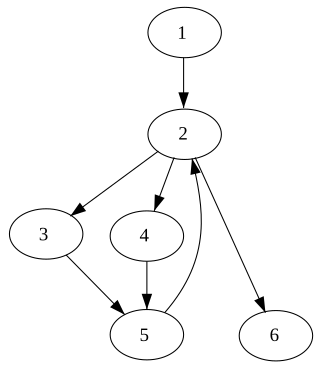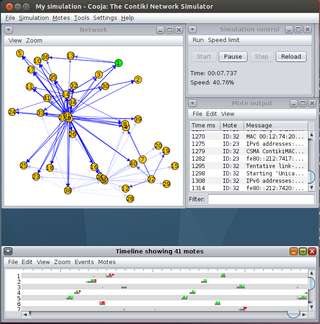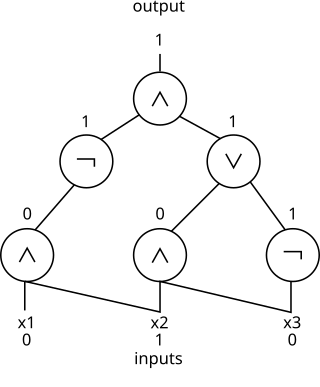Related Research Articles
Distributed computing is a field of computer science that studies distributed systems, defined as computer systems whose inter-communicating components are located on different networked computers.

Leslie B. Lamport is an American computer scientist and mathematician. Lamport is best known for his seminal work in distributed systems, and as the initial developer of the document preparation system LaTeX and the author of its first manual.

In computer science, a node d of a control-flow graph dominates a node n if every path from the entry node to n must go through d. Notationally, this is written as d dom n. By definition, every node dominates itself.

Contiki is an operating system for networked, memory-constrained systems with a focus on low-power wireless Internet of Things (IoT) devices. Contiki is used for systems for street lighting, sound monitoring for smart cities, radiation monitoring and alarms. It is open-source software released under the BSD-3-Clause license.
Wireless sensor networks (WSNs) refer to networks of spatially dispersed and dedicated sensors that monitor and record the physical conditions of the environment and forward the collected data to a central location. WSNs can measure environmental conditions such as temperature, sound, pollution levels, humidity and wind.
Clock synchronization is a topic in computer science and engineering that aims to coordinate otherwise independent clocks. Even when initially set accurately, real clocks will differ after some amount of time due to clock drift, caused by clocks counting time at slightly different rates. There are several problems that occur as a result of clock rate differences and several solutions, some being more acceptable than others in certain contexts.
MapReduce is a programming model and an associated implementation for processing and generating big data sets with a parallel and distributed algorithm on a cluster.
Jensen's device is a computer programming technique that exploits call by name. It was devised by Danish computer scientist Jørn Jensen, who worked with Peter Naur at Regnecentralen. They worked on the GIER ALGOL compiler, one of the earliest correct implementations of ALGOL 60. ALGOL 60 used call by name. During his Turing Award speech, Naur mentions his work with Jensen on GIER ALGOL.
Replication in computing refers to maintaining multiple copies of data, processes, or resources to ensure consistency across redundant components. This fundamental technique spans databases, file systems, and distributed systems, serving to improve availability, fault-tolerance, accessibility, and performance. Through replication, systems can continue operating when components fail (failover), serve requests from geographically distributed locations, and balance load across multiple machines. The challenge lies in maintaining consistency between replicas while managing the fundamental tradeoffs between data consistency, system availability, and network partition tolerance – constraints known as the CAP theorem.

Edge computing is a distributed computing model that brings computation and data storage closer to the sources of data. More broadly, it refers to any design that pushes computation physically closer to a user, so as to reduce the latency compared to when an application runs on a centralized data centre.
A wireless ad hoc network (WANET) or mobile ad hoc network (MANET) is a decentralized type of wireless network. The network is ad hoc because it does not rely on a pre-existing infrastructure, such as routers or wireless access points. Instead, each node participates in routing by forwarding data for other nodes. The determination of which nodes forward data is made dynamically on the basis of network connectivity and the routing algorithm in use.

In theoretical computer science, circuit complexity is a branch of computational complexity theory in which Boolean functions are classified according to the size or depth of the Boolean circuits that compute them. A related notion is the circuit complexity of a recursive language that is decided by a uniform family of circuits .
Geographic routing is a routing principle that relies on geographic position information. It is mainly proposed for wireless networks and based on the idea that the source sends a message to the geographic location of the destination instead of using the network address. In the area of packet radio networks, the idea of using position information for routing was first proposed in the 1980s for interconnection networks. Geographic routing requires that each node can determine its own location and that the source is aware of the location of the destination. With this information, a message can be routed to the destination without knowledge of the network topology or a prior route discovery.
Michael John Fischer is an American computer scientist who works in the fields of distributed computing, parallel computing, cryptography, algorithms and data structures, and computational complexity.

The friendship paradox is the phenomenon first observed by the sociologist Scott L. Feld in 1991 that on average, an individual's friends have more friends than that individual. It can be explained as a form of sampling bias in which people with more friends are more likely to be in one's own friend group. In other words, one is less likely to be friends with someone who has very few friends. In contradiction to this, most people believe that they have more friends than their friends have.
The Brooks–Iyengar algorithm or FuseCPA Algorithm or Brooks–Iyengar hybrid algorithm is a distributed algorithm that improves both the precision and accuracy of the interval measurements taken by a distributed sensor network, even in the presence of faulty sensors. The sensor network does this by exchanging the measured value and accuracy value at every node with every other node, and computes the accuracy range and a measured value for the whole network from all of the values collected. Even if some of the data from some of the sensors is faulty, the sensor network will not malfunction. The algorithm is fault-tolerant and distributed. It could also be used as a sensor fusion method. The precision and accuracy bound of this algorithm have been proved in 2016.
A distributed operating system is system software over a collection of independent software, networked, communicating, and physically separate computational nodes. They handle jobs which are serviced by multiple CPUs. Each individual node holds a specific software subset of the global aggregate operating system. Each subset is a composite of two distinct service provisioners. The first is a ubiquitous minimal kernel, or microkernel, that directly controls that node's hardware. Second is a higher-level collection of system management components that coordinate the node's individual and collaborative activities. These components abstract microkernel functions and support user applications.
A distributed file system for cloud is a file system that allows many clients to have access to data and supports operations on that data. Each data file may be partitioned into several parts called chunks. Each chunk may be stored on different remote machines, facilitating the parallel execution of applications. Typically, data is stored in files in a hierarchical tree, where the nodes represent directories. There are several ways to share files in a distributed architecture: each solution must be suitable for a certain type of application, depending on how complex the application is. Meanwhile, the security of the system must be ensured. Confidentiality, availability and integrity are the main keys for a secure system.
Multitier programming is a programming paradigm for distributed software, which typically follows a multitier architecture, physically separating different functional aspects of the software into different tiers. Multitier programming allows functionalities that span multiple of such tiers to be developed in a single compilation unit using a single programming language. Without multitier programming, tiers are developed using different languages, e.g., JavaScript for the Web client, PHP for the Web server and SQL for the database. Multitier programming is often integrated into general-purpose languages by extending them with support for distribution.
Flix is a functional, imperative, and logic programming language developed at Aarhus University, with funding from the Independent Research Fund Denmark, and by a community of open source contributors. The Flix language supports algebraic data types, pattern matching, parametric polymorphism, currying, higher-order functions, extensible records, channel and process-based concurrency, and tail call elimination. Two notable features of Flix are its type and effect system and its support for first-class Datalog constraints.
References
- 1 2 3 Casadei, Roberto (2023-01-11). "Macroprogramming: Concepts, State of the Art, and Opportunities of Macroscopic Behaviour Modelling". ACM Computing Surveys. 55 (13s). Association for Computing Machinery (ACM): 1–37. arXiv: 2201.03473 . doi:10.1145/3579353. ISSN 0360-0300. S2CID 245837830.
- ↑ Casadei, Roberto (2023-11-01). "Artificial Collective Intelligence Engineering: A Survey of Concepts and Perspectives". Artificial Life. 29 (4). MIT Press: 433–467. arXiv: 2304.05147 . doi:10.1162/artl_a_00408. ISSN 0360-0300.
- ↑ Newton, Ryan; Welsh, Matt (2004). "Region streams". Proceeedings of the 1st international workshop on Data management for sensor networks in conjunction with VLDB 2004 - DMSN '04. New York, New York, USA: ACM Press. p. 78. doi:10.1145/1052199.1052213.
- 1 2 Newton, Ryan; Morrisett, Greg; Welsh, Matt (2007). "The regiment macroprogramming system". Proceedings of the 6th international conference on Information processing in sensor networks - IPSN '07. New York, New York, USA: ACM Press. p. 489. doi:10.1145/1236360.1236422. ISBN 978-1-59593-638-7.
- ↑ Gummadi, Ramakrishna; Gnawali, Omprakash; Govindan, Ramesh (2005). "Macro-programming Wireless Sensor Networks Using Kairos". Distributed Computing in Sensor Systems. Berlin, Heidelberg: Springer Berlin Heidelberg. pp. 126–140. doi:10.1007/11502593_12. ISBN 978-3-540-26422-4. ISSN 0302-9743.
- ↑ Júnior, Iwens G. S.; Santana, Thalia S. de; Bulcão-Neto, Renato de F.; Porter, Barry F. (2022-11-18). "The state of the art of macroprogramming in IoT: An update". Journal of Internet Services and Applications. 13 (1). Sociedade Brasileira de Computacao - SB: 54–65. doi: 10.5753/jisa.2022.2372 . ISSN 1869-0238. S2CID 254365168.
- ↑ Mottola, Luca; Picco, Gian Pietro (2011). "Programming wireless sensor networks". ACM Computing Surveys. 43 (3). Association for Computing Machinery (ACM): 1–51. doi:10.1145/1922649.1922656. hdl: 11311/635123 . ISSN 0360-0300. S2CID 1837434.
- ↑ Casadei, Roberto; Viroli, Mirko; Aguzzi, Gianluca; Pianini, Danilo (2022). "ScaFi: A Scala DSL and Toolkit for Aggregate Programming". SoftwareX. 20. Elsevier BV: 101248. doi:10.1016/j.softx.2022.101248. hdl: 11585/903248 . ISSN 2352-7110.
- ↑ Azzara, Andrea; Alessandrelli, Daniele; Bocchino, Stefano; Petracca, Matteo; Pagano, Paolo (2014). "PyoT, a macroprogramming framework for the Internet of Things". Proceedings of the 9th IEEE International Symposium on Industrial Embedded Systems (SIES 2014). IEEE. pp. 96–103. doi:10.1109/sies.2014.6871193. ISBN 978-1-4799-4023-3.
- ↑ Madden, Samuel R.; Franklin, Michael J.; Hellerstein, Joseph M.; Hong, Wei (2005). "TinyDB: an acquisitional query processing system for sensor networks". ACM Transactions on Database Systems. 30 (1). Association for Computing Machinery (ACM): 122–173. doi:10.1145/1061318.1061322. ISSN 0362-5915. S2CID 2239670.